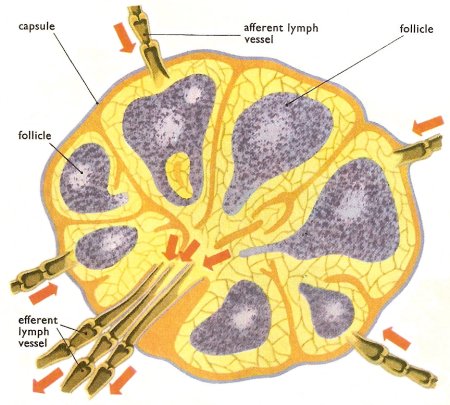lymph node

Section through a lymph node showing the arrangement of vessels.
A lymph node is one of a number of small swellings found at intervals along the lymphatic system. Lymph nodes are small bean-shaped structures, usually less than 2.5 centimeters (1 inch) in length. They are widely distributed throughout the body along the lymphatic pathways where they filter the lymph before it is returned to the blood. Lymph nodes are not present in the central nervous system.
There are three superficial regions on each side of the body where lymph nodes tend to cluster. These areas are the inguinal nodes in the groin, the axillary nodes in the axilla (armpit), and the cervical nodes in the neck.
The typical lymph node is surrounded by a fibrous envelope or capsule from which trabecu;ae extend inwards. Within the capsule is the cortex, which is divided into compartments called lymph nodules or lymph follicles. The lymph nodules are dense masses of lymphocytes and macrophages and are separated by spaces called lymph sinuses. In the center are the irregular masses of the medulla.
Several afferent lymphatic vessels, which carry lymph into the node, enter the node on the convex side. The lymph moves through the lymph sinuses and enters an efferent lymphatic vessel, which carries the lymph away from the node. Because there are more afferent vessels than efferent vessels, the passage of lymph through the sinuses is slowed down, which allow time for the cleansing process. The efferent vessel leaves the node at an indented region called the hilum. Groups of nodes are found in many parts of the body; for example, in the groin and armpit and behind the ear. They are composed of lymphoid tissue and act as filters for the lymph, preventing foreign particles from entering the bloodstream; they also produce lymphocytes.
Disorders of the lymph nodes
Inflammation of the lymph nodes is called lymphadenitis and is a common cause of lymphadenopathy (swollen lymph nodes). A condition called persistent generalized lymphadenopathy, which causes generalized swelling of the lymph nodes, develops in some people infected with HIV (the AIDS virus).


